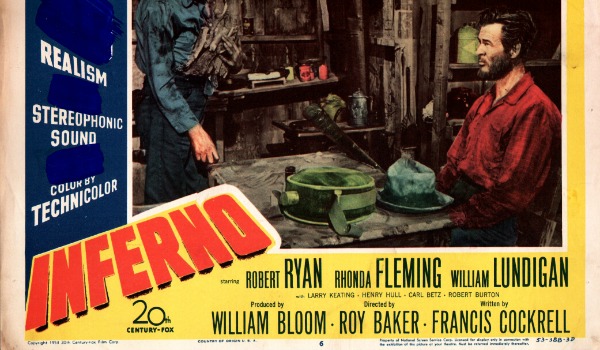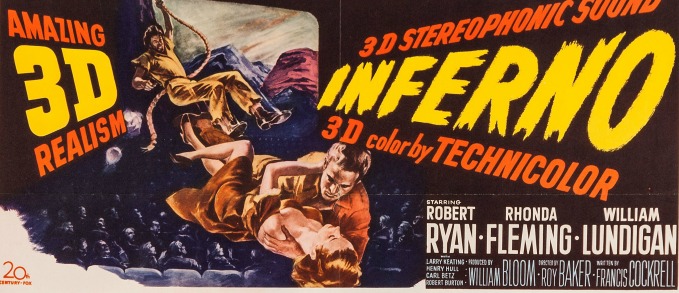A fine performance by star Robert Ryan and the majesty of the Mojave desert in 3D bolster this unusual film noir, played out under the blazing sun.
Over the past few years 3D technology has become more integrated into contemporary cinema’s mainstream; since James Cameron’s smash blockbuster AVATAR it has begun to absorb a surprising amount of the cinema atmosphere. Despite heavy exposure in recent times it is much regarded as a ‘modern’ technology. However, Roy Baker’s 1953 INFERNO is a glorious testament to prove that 3D technology was a marvel many years earlier.
The dusty landscape of the Mojave Desert is the primary setting for a tale of betrayal, tension, deceit and one man’s desperate struggle for life. Robert Ryan plays Donald Carson, a feisty millionaire, left for dead by his wife Geraldine (Rhonda Fleming) and prospector and all-round sleaze Joseph Duncan (William Lundigan) who have begun an adulterous relationship. With a broken leg, a gallon of water, and a pitiful amount of food, Carson must battle his way through the mountainous terrain in which he has been stranded.
“The clarity and overwhelming sparseness of the Mojave Desert is nothing short of spectacular…”
INFERNO could easily be mistaken at first glimpse for a western. It is not. INFERNO is an incredibly-shot noir, in an unconventional landscape: hot, desolate and bright, extinguishing the tradition of dark and secluded noir settings. Consistency to the noir genre is retained with the presence of femme fatale Geraldine, two males entangled by the beautiful female, and one eventually led to his demise: an oh-so familiar tradition.
3D technicolor provides the Mojave Desert with a clarity and overwhelming sparseness that is depicted beautifully, and nothing short of spectacular. Although nothing flies out of the screen towards the audience until near the end of the film, this is not why Baker shot in 3D. He did it to add character to a landscape that would otherwise appear flat. It is for this reason, in particular, that the technology has worked so well for Baker.
Audio elements give a real edge to INFERNO. The soundtrack is eerie and desolate when focusing on Carson’s struggle out of the mountains, mixed with elated notes when Carson has small victories in his downward journey. This, combined with the emotive use of a voiceover for Carson’s thoughts instead of live dialogue, is very clever and adds a very human element.
“Though the storyline falters in places it is more than made up for aesthetically…”
The film has been so well crafted and shot that the story falls down in comparison. Since it is focused mostly on Carson’s escape, the relationship between Carson and Geraldine is not explored as fully as it should be; likewise with Carson and Duncan. The saving grace of the storyline is that we are so drawn into our protagonist’s escape that the background detail seems irrelevant. The scenes which show Geraldine and Duncan together, and the growing search party for Carson, do little to bulk out the story, which is frustrating at times. Yet so long as Carson has a chance to escape the audience is happy.
INFERNO 3D is a rare piece of cinema mastery which demonstrates the perfect use for 3D technology, and many modern directors could profitably take its lessons on board. Though the storyline falters in places, it is more than made up for aesthetically, and nothing can be taken away from a superb performance by Robert Ryan, and the magnificently captured natural performance of the Mojave Desert.
httpvh://youtu.be/Y1t6nN6SbYI


